What is a Thermistor?
A thermistor is a type of thermal resistor whose electrical resistance increases or decreases with a change in temperature. Thus, the thermistors are thermally sensitive resistance whose resistance changes with a change in the thermistor’s body temperature. We will discuss the working principle of thermistors. How PTC and NTC thermistors function and the applications of thermistors will be discussed in the later sections.
Thermistor symbol
The symbol of the thermistor is depicted in the figure below.
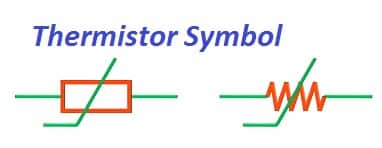
The symbol of the thermistor is as given below. The thermistor is a passive circuit element. The passive component does not require any external power supply for its operation. The thermistor is very sturdy and cheap and can be used to measure the temperature accurately. The thermistor does not function reliably in extremely hot or cold temperatures. Therefore, thermistors are most suitable for applications where precision temperature measurement is required.
Working Principle of Thermistor
The resistance of the thermistor changes with a change in the thermistor’s body temperature. The resistance of the thermistor does not vary linearly with changes in temperature. The thermistor has a non-linear resistance temperature curve. The resistance of the thermistor can be measured using a resistance meter(Ohm-meter). By knowing the exact relationship between the change in the resistance and temperature, the temperature can be derived by measuring the resistance of the thermistor at a particular temperature. The change in the thermistor resistance with temperature depends on the type of material used for thermistor construction. The plot between temperature and resistance of a thermistor is as given below.
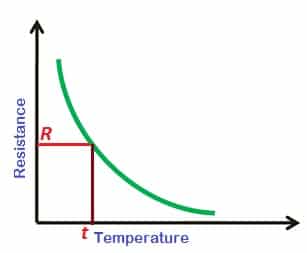
From the above graph, we can measure the temperature by measuring the resistance of the thermistor. The procedure of temperature measurement is as follows.
- Measure the resistance of the thermistor by using an Ohm-meter.
- Draw a vertical line across from the resistance on the y-axis and drawing a vertical line down from where this horizontal line intersects with the graph, we can hence derive the temperature.
Types of Thermistor
The thermistors are classified according to increase or decrease in thermistor resistance with variation in temperature. There are two types of thermistors.
- Negative Temperature Coefficient (NTC) Thermistor
- Positive Temperature Coefficient (PTC) Thermistor
NTC Thermistor
The NTC thermistor has a negative temperature coefficient. Its resistance decreases with an increase in temperature and increases when temperature decreases. Thus, the resistance and temperature are inversely proportional in the NTC thermistor. The electric current flow through the NTC thermistor increases with the increase in temperature.
With the increase in temperature, a large number of charge carriers or free electrons collide with valence electrons of another atom. The valence electrons, which gain sufficient energy, will break the bonding with the parent atom and move freely from one place to another. The electrons that move freely from one place to another are called free electrons. Thus, the free electrons increase due to the rapid collision of the free electrons with the atom. The small increase in temperature produces millions of free electrons. The more free electrons cause a rapid increase in electric current. Thus, the small increase in temperature causes a rapid decrease in the temperature and allows a large current flow through the thermistor.
Resistance-temperature equation of NTC Thermistor
The resistance of the NTC thermistor decreases with an increase in temperature. The relationship between the temperature and resistance is governed in the NTC thermistor by the following mathematical expression.
The equation of the thermistor is highly nonlinear. A standard NTC thermistor usually exhibits a negative thermal resistance temperature coefficient of about 0.0045 per degree Kelvin.
The Beta (β) value of a thermistor is an indicator of the slope of the resistance-temperature curve characteristic.
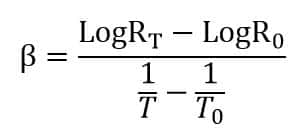
The higher value β shows a good relationship between the resistance and temperature. A small increase in temperature will cause a decrease in the resistance if the value of β is high. Thus, higher sensitivity and accuracy can be achieved if the value of β is high.
From equation (1), the temperature coefficient of the thermistor can be given as;
Equation (2) shows that the thermistor has a negative temperature coefficient.
If β= 4000 K and T = 298 K, then the αT = 0.0045/∘K temperature coefficient. The temperature coefficient of the thermistor is much higher than the sensitivity of the platinum RTD.
PTC Thermistor
The resistance of the PTC thermistor increases with the increase in temperature. PTC thermistors are made from doped polycrystalline ceramic. Thermistors with a Positive Temperature Coefficient (PTC) are also called posistors. The plot between the resistance and temperature of a PTC thermistor is given below.
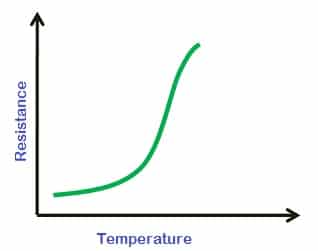
The PTC thermistors are not as popular as NTC thermistors. The PTC thermistors are used in circuit protection. When current passes through the PTC thermistor, it causes heating. In a PTC thermistor, this heating up will also cause an increase in resistance. This creates a self-reinforcing effect that drives the resistance upwards, therefore limiting the current. Thus, the PTC thermistor is used as a current limiting device.
Thermistor Construction
The thermistors are made with a sintered mixture of metallic oxides like manganese, cobalt, copper, iron, nickel, uranium, etc. These oxides are blended in a suitable proportion and compressed into the desired shape, and they are heat-treated to recrystallize.
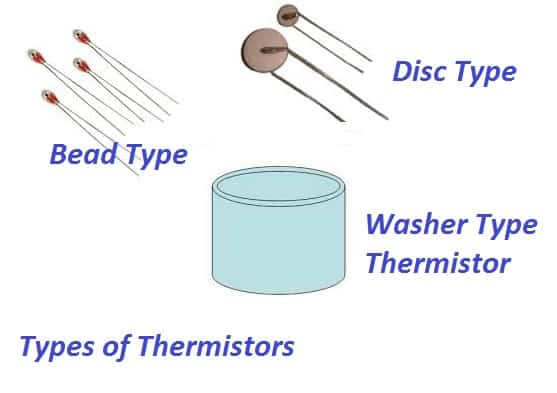
Different shapes and sizes of thermistors are available on the market. Thermistors are available in the form of beads, disks, and washers. The size of the thermistor in the form of beads is in the range of 0.15 millimeters to 1.5 millimeters in diameter. Thermistors in the form of disks and washers are made by pressing the thermistor material under high pressure into flat cylindrical shapes with diameters from 3 millimeters to 25 millimeters.
The typical size of a thermistor is 0.125mm to 1.5 mm. The thermistors are available in the nominal values of 1K, 2K, 10K, 20K, 100K, etc. The resistance value of the thermistor is at a temperature of 25oC. The major advantages of thermistors are their small size and relatively low cost.
Thermistor Applications
The thermistors are widely used in many temperature measurement applications, including air and liquid temperature measurement. Some of the applications are given below.
- Used in medical instruments
- Digital thermometers
- In-home appliances such as ovens, hair dryers, toasters, microwaves, fire alarms and refrigerators
- To measure oil and coolant temperature in the car
- Measurement of thermal conductivity of electrical materials
- For surge protection
- As an inrush current limiter
- Used in basic electronics circuit
- Used in temperature measurement of motor
- For temperature compensation circuit
- Used in Wheatstone bridge
- Digital thermometer
- Used in aerospace, communication, and instrumentation field